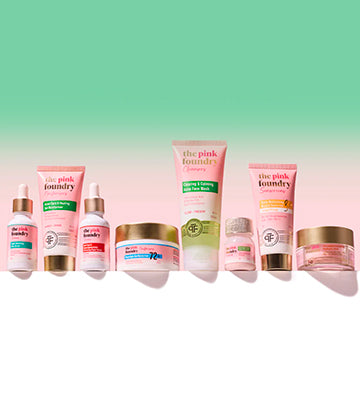Alpha Hydroxy Acid (AHA) in Skincare

Introduction
Improving the texture of our skin and getting rid of acne is a dream many of us have dreamt. When it comes to the treatment of these issues, alpha hydroxy acid plays a massive role. They are a group of acids that come naturally from milk and fruits. From exfoliation to better skin texture, if you plan on a new skincare regime, this ingredient is a must for your cupboard.
Did you know that the demand for AHA has surged worldwide because of the impact of global warming on the market for skincare items such as sunscreen lotions, creams, serums, and others?
This massive popularity makes sense, given it can improve the texture of your skin, correct hyperpigmentation, and protect you from sun damage, in addition to many of its benefits.
But what is the AHA meaning? What are the advantages of skincare? We will give you answers to all your questions in this blog.
What is AHA?
They are a group of acids that generally occur in specific foods. In the market, there are a lot of skincare treatments and products with AHAs in them for the exfoliation of skin.
Generally, they work by loosening the topmost layer of old skin cells. And they do it by keeping the skin cells joined together after breaking down the gluey substance. It encourages the skin to grow more cells, leading to better cell turnover.
What does AHA do for the skin?
Now that you know what is AHA, let us take a look at what it does for the skin. Firstly, good news for you: the ingredients are safe on all skin tones and are gentler on the skin than most cleansing brushes and scrubs might ever be. These ingredients decrease the bond between the skin cells, which enables them to dissociate more freely in a controlled manner.
With that, more refined and fresher skin starts to appear, smoother and more hydrated. Anyone looking for fresh and acne-free skin must add this to their skincare routine.
What are the types of AHAs for the skin?
Before we take a look at aha skin benefits, let us understand the different kinds of AHAs for skin:
-
Glycolic acid
It is a chemical exfoliant that naturally occurs in sugarcane. It is known to be the smallest AHA that is water soluble. Therefore, it can penetrate deeper into the skin, which is the basal layer of the epidermis. It is where the melanin accumulation happens. But what are its benefits for the skin? Well, glycolic acid as an AHA speeds up skin renewal and eliminates the melanin accumulation cell by cell. It is one of the most known AHAs widely utilised as a key skincare ingredient.
-
Malic acid
It is one of the classes of AHAs that are present in apples. They assist in cleansing and rejuvenating the skin and keep it hydrated. Moreover, they reduce the wrinkle appearance on your skin and prevent acne.
-
Mandelic acid
Made from almond extracts, it is one of the AHAs that may be combined with other potent AHAs to enhance exfoliation. However, when used alone or in the skincare product, it enhances pore size and skin texture.
-
Lactic acid
This one is one of the mildest kinds of AHA. It assists in increasing the turnover of cells. Moreover, lactic acid eliminates dead cells on the top of the skin layer. It is present in dairy and fermented vegetables. Lactic acid effectively correct moderate to dangerous hyperpigmentation and fade away wrinkles and visible pores.
-
Citric acid
It is present in citrus fruits, and it helps with skin exfoliation. When used in massive concentrations, it best works to exfoliate the skin. However, when used in a lower concentration, it works as an antioxidant and a pH adjuster.
-
Tartaric acid
It is yet another kind of AHA that comes from grape extracts. It can help you treat acne and the signs of sun damage on the skin.
Due to their different skin penetration abilities, the AHAs can work on various skin issues.
AHA benefits in skincare
Now that you know different kinds of AHA in skin care, let us take a look at some of its biggest benefits for our skin:
-
Gentle exfoliation
AHAs may be a good option for other methodologies of exfoliation, like using abrasive brushes, facecloths, and scrubs. These procedures of mechanical exfoliation might be harsh and cause irritation. Remember, exfoliation with a low-strength AHA can suit sensitive skin people.
-
Decreasing the ageing signs
Over time and with sun exposure, the new skin cell turnover slows down. It can follow up to the formation of wrinkles and fine lines. The AHAs are known to remove the topmost layer of the dead skin cells. With that, it reveals the fresh new cells below. Its long-term use can also enhance the skin's elastin and collagen levels.
-
Decreasing acne
The AHAs can assist some folks in preventing acne by eliminating the dead skin cells, which can block the pores and cause pimples.
Precautions while using alpha hydroxy acid on skin
Before you use any products that contain AHA, make sure to:
- Test it on a small area of the skin before using it on larger areas
- In case you feel stinging or irritation, rinse it thoroughly and do not use the product
- If there is no reaction like that, just follow the product's instructions and use it on your face.
Other than that, here is what you need to know about the recommendations of experts when it comes to skincare products:
- Make sure the AHA concentration of the product is 10% or less
- The pH should be above 3.5
- There should be SPF protection with the product.
Wrapping Up
From helping with breakouts to boosting the efficiency of other skincare products on the skin, AHA is one of the versatile ingredients for skincare products. However, one should always be wary of the precautions we mentioned before going ahead and using the product regularly.

